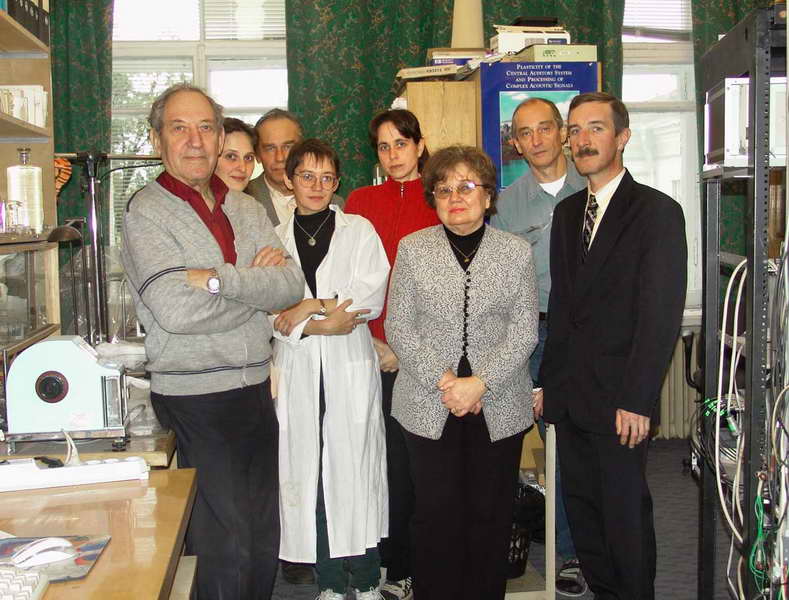Systematic studies of auditory physiology started at the Institute from 1936 under the guidance of Prof. G. V. Gershuni (since 1964, the Corresponding Member of the USSR Academy of Sciences) at the Laboratory of physiology of sense organs that he headed.
In the late 1930s, the « electrophonic effect » was described: electrical stimulation of cochlea produced an auditory sensation. These works turned out to be several decades ahead of investigations on the hearing electrode prosthetics. In electrophysiological studies of the auditory system, for the first time in the world, microphone potentials of human cochlea were recorded and detailed data were obtained on total electrical reactions of various auditory system parts. During the years of the Great Patriotic War, the studies that were predominantly of an applied character were aimed mainly at studying the auditory and localizational functions during bullet brain wounds and air contusions. Further development of these investigations allowed formulating the concept of the objectively recorded reactions appearing below the hearing threshold (subsensory reactions). In 1949 the cycle of G. V. Gershuni's works on the subsensory perception was awarded I. P. Pavlov Premium of the USSR Academy of Sciences. In the 1950s, use of a set of human objective reactions for testing the auditory function became the basis for the so-called objective audiometry. At the same period, to study the auditory system, electrophysiological methods (evoked potentials, recording of activity of individual neurons) were widely used; this allowed studying in detail the activity of various auditory system parts in the consciousness and narcosis states and revealing regulatory changes of afferent impulsation in the auditory system. Under effects of sound signals of different duration two extreme neuronal groups are detected, which indicate realization of the auditory function in systems with different time constants.
 Since 1972, the head of the Laboratory is Prof. Ya. A. Altman (from 1997, the Corresponding Member of the Russian Academy of Sciences). Since 1972, the head of the Laboratory is Prof. Ya. A. Altman (from 1997, the Corresponding Member of the Russian Academy of Sciences).
The main direction of works becomes studying acoustic spatial orientation. At study of mechanisms of localization of immobile sound sources in space the character of transformation of afferent impulsation along the auditory pathway is described as well as the neurons are described for the first time, which react by a specialized reaction to direction of sound movement. For the last few years the main attention is paid to study of perception of moving sound sources. Using the psychoacoustic method, the main characteristics of perception of the sound source movement in the horizontal plane are established. By the behavioral method, the necessity of the presence of intact auditory cortex is established to provide localization of the moving sound source. Besides, when examining patients, the right subdominant human brain hemisphere was shown to play the leading role in providing localizational function. Based on studying electrical responses of various integrating motor brain structures, a statement is formulated that the final recognition of localizational characteristics of sound signals can be performed in these « unspecific » brain structures, whereas the auditory system merely supplies data for this recognition. In 1994, for his works in the field of the sound source localization, Ya. A. Altman was awarded I. M. Sechenov Gold Medal of the Presidium of the Russian Academy of Sciences.
Subsequently, mechanisms of the human spatial hearing (study of evoked auditory potentials) were analyzed electrophysiologically. At present, a detailed characteristic of perception of the sound image movement in the plane and during its approaching and moving away is performed. Besides, there is studied effect of the moving sound sources on human motor control and on movement illusions; thereby, a way of studying the virtual reality is outlined not only in the sensory sphere, but also in its interaction with the illusory movement in the motor sphere. |